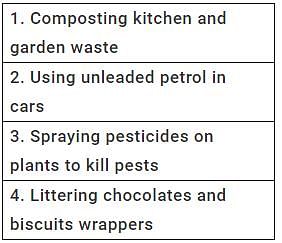Test: Environment And Its Conversation - 2 - Class 5 MCQ
15 Questions MCQ Test Additional Study Material for Class 5 - Test: Environment And Its Conversation - 2
The given symbol is commonly seen on consumer products such as microwaves, refrigerators and lighting devices. What does this symbol indicate about the product?


| 1 Crore+ students have signed up on EduRev. Have you? Download the App |
To check the level of harmful gases emitted by the vehicles, all vehicles in India which are in use need to obtain emission check certificate. What is this certificate known as?
If an earthquake occurs, what you should do?
By which of the following ways can we save water?
Which of the following statements is incorrect regarding the conservation of the environment?
Raj is travelling with his father in a car. He asks his father to turn off the engine at red lights in order to conserve a natural resource. Which of the following is being conserved by this activity?
Given below is the cascade of events following deforestation. Select the option which arrange them in the correct sequence.

If there is a large amount of rainfall in a short period of time, it can lead to
Which of the following actions will help to reduce pollution?

Natural processes change the surface of the Earth. Some changes occur rapidly and some occur slowly. Which of the following would cause the fastest change in Earth's surface?
The place where an earthquake originates is called ______.
The Tsunami that occurred in Japan in 2011 was due to ____.
Which of the following is the most environment- friendly way of bathing?
|
10 docs|23 tests
|
|
10 docs|23 tests
|

















